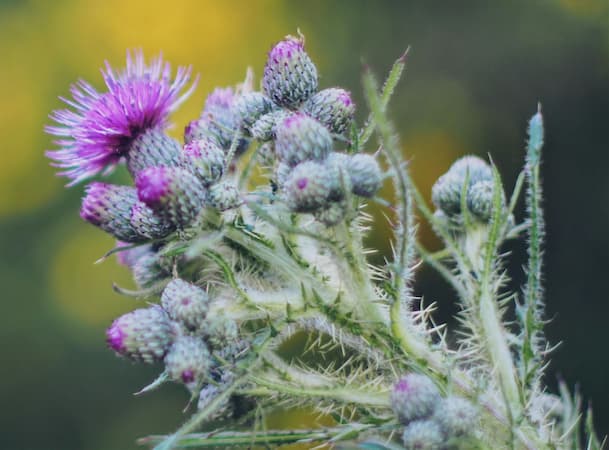How to Grow Thistle Flowers - - or Thistle Weeds

About Growing Thistle plants in Your Flower Garden
Thistle plants are a wildflower. Thistle is an invasive weed. Depending upon who you talk to, they are either interested in growing thistle flowers to feed the backyard birds, or trying to get them out of the lawn or backfield. There are hundreds of varieties, many of which, are invasive. They quickly spread through pastures. Cows will not graze near them. Others are grown by gardeners for their flowers. Many of these gardeners, also grow thistle to attract finches to their yards. Goldfinches just love the seeds.
Here are some comments we’ve heard about this plant:
- “Thistle is a flower, which gardeners enjoy growing.”
- “To me, these plants are nothing more than an invasive weed, and not easy to control.”
- “Thistle plants are great to have around the yard to attract goldfinches.”
- “I love Milk Thistle. Its milky sap serves my medical ailment.”
Boy, if you were a thistle plant, you’d probably have a personality complex, suffering from multiple personalities. There is indeed a love-hate relationship….. either you love it, or you hate this plant.
Milk Thistle has medicinal applications and has been in use since the Roman Empire. Most notably, it has been used to treat liver ailments. It has also been used to treat kidney and spleen problems.
What Birds like Thistle Seeds? All kinds of finches, most notably, goldfinches, like the seeds. Mourning Doves, and Juncos, a type of Sparrow, also like thistle. The seeds have lots of fats, nutrients, and protein. They are great for your winter bird feeder.
Did You Know? Artichokes are a member of the Thistle family.
Thistle Flower Plant Specifications
Flower Colors: Most flowers are Purple. However, there are varieties that produce varying shades of blue, pink, purple, and yellow.
Flowers Bloom: Summer.
Plant height: Two to three feet tall.
Ideal pH Level: 6.0 – 6.5.
Plant Hardiness Zones: 5 – 9
Light Needs: Full sunlight.
Toxic Plant?: Yes.
Deer Resistant? Yes. Deer do not like the strong scent and bitter taste of Thistle. So, the plants are not on the menu of deer, rabbits, and other foraging animals.
Number of Species: 60.
Plant Type: Most are perennials. A few annual varieties.
Native To: Asia and Europe.
Botanical Name: Cirsium
Other Names: Thistle Weeds
Are Thistle Plants Edible?
YES, if ingested in large amounts.
During our research, we encountered conflicting articles. Some articles say Thistle is poisonous, while others claim it is edible. Our conclusion is it is poisonous if consumed in large amounts. Some people may be more sensitive to the toxins in the plant than others.
As a result of this conflicting information, we recommend you do not consume any part of this plant.
Medicinal Uses for Thistle Flowers
Thistle plants have a variety of medicinal applications. Among other things, it has anti-inflammatory properties. Here are a few of them:
- Reduce inflammation.
- Use it for cancer prevention and treatment.
- It treats gallbladder and liver disorders.
- It helps to balance blood sugar.
Light Requirement
Thistle plants grow and bloom best in full, direct sunlight. Plant them in a location where they will receive at least eight to ten hours of bright sunlight every day. While they may tolerate a little light shade, too much shade results in leggy plants and fewer flowers.
Thistle Plant Propagation
The plants are grown from seed. They also readily propagate through their roots (rhizomes). New plants develop from buds on the root system. And, in many varieties, this growth is very aggressive.
Final Plant Spacing: Space plants one to two feet apart.
Days to Germination: Seeds sprout in 14 – 28 days.
How to Grow Thistle Flower Plants
Planting location and soil needs:
Thistle weeds are easy to grow and low maintenance. It’s one of the reasons it makes a good wildflower. Select a planting location where they will receive full sunlight all day long. They grow well in some of the poorest garden soil. The first time you plant them, mix in a general amount of compost. After planting them, add a general-purpose fertilizer, especially if the soil is poor. Then, water the planting area.
Once your Tansy plants are established, they should grow well with few problems and no maintenance.
Fertilizer needs:
Save your money. Established plants grow well without the need for additional fertilizers during the growing season.
Water needs:
Thistle flowers are drought tolerant. Water them only when the soil has dried out during extended periods of hot and dry weather.
Other steps:
If you are growing these plants, use garden flowers. The plants have many sharp thorns.
The stems may droop under the weight of the heavy flower heads. Stake the plants if needed.
Pruning
Thistle weeds require little or no pruning. Simply remove the occasional sick, dead, or damaged leaves as you spot them.
Allow the flower heads to remain on the plant to ripen the seeds. Then, the birds will flock to the plant to feed.
And, don’t forget to save some of the seeds to plant next season.
Insects and Plant Disease
Most herbicides will kill off the plant, but new ones can still emerge from the root system.
So, for established plants, it is important to dig up the rhizomes. And, if you do not remove the entire rhizome, this noxious and invasive weed will regrow.
Also see: Plant Problems – Identify the causes and find the cures.
Related Articles
Also, people who read this article on Thistle Flowers will like:
Please support our site. Shop for:
- rmmatthews100@hotmail.com
- 585-721-6528
- Rochester, NY
©1999-2024 GardenersNet.Com, All Rights Reserved

